By David Kronke
With Hurricane Sandy bearing in ominously on the Northeastern Seaboard and officials urging locals to evacuate or brace themselves in their boarded-up homes, Orrie Hicks’ father was incredulous: “You’re going to work?”
For Hicks of Baltimore’s CBS affiliate WJZ and other news directors in New York and Philadelphia, there was simply no question. “I said, ‘Dad, I work in the news,’” he recalls with a laugh. “Hospital workers and police officers; that’s what they have to do. With my job, staying home is not an option.”
“Our families had to treat us like they were married to a first responder,” agrees Michael Haynes, coordinating director for New York’s WCBS.
Sandy, which made landfall on Oct. 29, was a storm of unprecedented size and fury. It destroyed thousands of homes, left millions without electricity for days and caused an estimated $50 billion in damage. It destroyed entire neighborhoods and iconic tourist sites such as the Atlantic City Boardwalk; it tossed cars, boats, houses and even a roller coaster around like they were mere playthings.
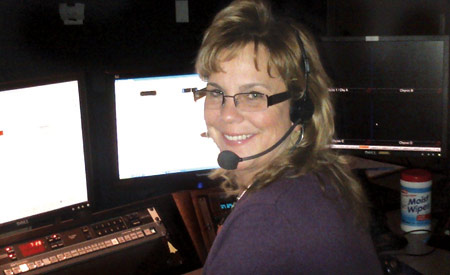
Leigh Pullekines, WCAU Philadelphia
News directors had to keep their composure over long hours as they processed a myriad of images of their cities getting pummeled, bringing as much information as possible to their viewers. Susan McNeeley, supervising director for New York’s WNBC, says, “I’ve been here through 9/11, countless blizzards, nor’easters and plane crashes, but nothing prepared me for Sandy. As a news director, I have often had a front row seat to history. "It’s always exciting to get a piece of the action, but this time the story became a little too personal.”
Since Sandy’s arrival was known well in advance, news directors had plenty of time to prepare for their coverage. “We knew it was coming days ahead of time,” says Haynes, echoing the sentiments of other directors, “so there was a lot of planning. In addition to overseeing live broadcasts, I had to make sure we were properly staffed and brought in other directors and associate directors. We went with an all-hands-on-deck approach.”
“Our meteorologists gave us the worst case scenario about five days out and we started preparing,” explains Don Horner, senior producer-director for WBAL in Baltimore. “As we got closer to Sandy coming ashore, things started to look better for Maryland, but we didn’t cut back on our plans. Preparation is the key.”
Leigh Pullekines, news director for Philadelphia’s NBC affiliate WCAU, recalls, “We knew the beach communities along the New Jersey and New York coast were going to be impacted the most, so we staffed our reporters accordingly. Our geographic coverage spanned up and down the coast ranging from as far north as Manhattan, to as far south as Rehoboth Beach, Del. "We had 10 to 15 different reporters actively covering the storm between Sunday afternoon and Tuesday evening.”
Like news directors at other stations, Pullekines recruited reporters and photographers from network affiliates from Miami to Chicago to assist with coverage. Stations rented rooms in nearby hotels and set up cots and space for power naps. Given the length of on-air coverage WNBC aired live more or less continuously from Sunday, Oct. 28 through Wednesday, Oct. 31; WCAU aired an uninterrupted 55 hours of storm reportageÑmaking news staffs as close and comfortable as possible was essential to what they were trying to do.
Once the storm hit Monday night, says McNeeley, “Although we attempted to follow a news rundown of sorts, obviously it was merely a guide. The storm created its own rundown because we were forced to follow the signals at the time. Sandy dictated the path we took.” For Haynes, “The images were so awe-inspiring, you couldn’t help but react to it. But you still had to maintain focus as the director of the broadcast.”
“Information never comes in at a steady pace; it is usually all or nothing,” notes Horner. “Evaluating the importance of the information is always a balancing act. You want to give the reporters time to paint the picture at their location and talk to the locals but if new information comes in that is critical to the masses, you sometimes need to cut them short. As the live director, you need to keep an ear on what is happening on the air as well as listen to what the line producers want to do next. When it comes to pacing the show for the viewer, it really falls on the director to say, ‘That information can wait another 45 seconds’ or, ‘We need to get this new information on right now.’”
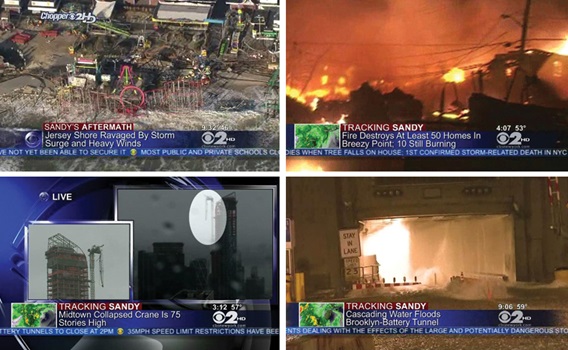
Though Horner like the other directors was working shifts of 12 hours or more (a few hours on the air, a couple off to facilitate further planning and check in on the well-being of friends and family), he noted, “When the adrenaline is pumping, you forget how many hours you have been sitting in the hot seat.”
He adds, drolly, “Control rooms are always compared to air traffic control towers, but honestly, if air traffic control towers had as many close calls as a television control room, no one would [want to] fly.”
Directors had to monitor a dizzying array of images emanating from their field reporters, as well as traffic cameras, beach webcams, weather graphics and, of course, their in-studio anchors and meteorologists. “My big monitor wall contains 30 or 40 pieces of information,” says Hicks, “and I can focus on anywhere between 15 and 20 images. The images I wanted to stay focused on were high tide on beach streets, flooding, and shots from traffic cameras. We focused on what was important at that time and try to show compelling video. If we saw flooding at a high level, we got that shot on the air. I would go to something especially compelling coming out of commercial breaks; I would tell the talent [to ad-lib], ‘We are coming to you with video from New Jersey or New York or Ocean City,’ etc.”
“At times it was a bit of a juggling act in terms of the producers figuring out which reporters had the best video, and what type of phoners [from correspondents] we had in the system to throw to,” says Randy Roditi, news director of New York’s Fox affiliate WNYW. “Some producers had a better game plan than others on where to go next.”
For example, Roditi says, “For the evacuees in Little Ferry [N.J.], the producer was tired of the scene of people waiting to be rescued. I felt it was important to stay with the live shot. After voicing my concern, he agreed and we were able to show some compelling video of an old woman being helped up a ladder onto an Army truck.”
In another instance, Roditi had footage of the 50 homes destroyed by a fire in the Queens neighborhood of Breezy Point. “The cameraman in the field was just on a steady wide shot covering the whole area,” he recalls. “I felt it would have more impact if he took the camera off the tripod and walked around the area so viewers at home could get a more personal look at the devastation that the fire had caused.”
“When it’s happening now, you’re in the mode where so much of it is the visuals; you take the video when you can and aren’t so concerned with the rough edges,” notes Haynes. “We didn’t worry if the talent could hear us, but we would go to them; we’d take that risk. You’re not getting a perfect, clean live shot. The situation we were in was one where live shots and feeds are constantly changing. Although we were reporting a lot of information; weather stats and forecasts, outages and closures; the truly compelling part of this story were the images and pictures coming in, both live and taped.
(above) Orrie Hicks, WJZ Baltimore (below) Susan McNeeley, WNBC New York
“Our anchors were in the studio,” continues Haynes, “but we made a conscious effort not to stay on them very much at all. After reporters were done with their live hits, we asked their photographers to stay with their shots and the events going on and we would go back to them to supplement our coverage. That all this destruction happened at night added to its eeriness.”
“What I put on television depended on several things,” says Paul Zucker of Philadelphia CBS affiliate KYW. “First, what was available to go on the air. We were obviously concerned about our crews’ well-being and we really had to rely on their instincts in the field to let us know, back in the studio, when and if they felt they were safe to go on the air.ÊMany crews were being pushed out of harm’s way by police. The weather conditions also limited the signals we could get back to the station.
“As director,” adds Zucker, “I was able to put my own little touch on certain parts of the show. It was up to me to pick the best images to truly tell the story. Bumpers in and out of breaks allowed me to be creative. By mixing live shots with recorded material, I was able to keep the coverage interesting and informative. One of my favorite bumpers was the footage of boats piled on top of one another.”
Where the storm would strike next wasn’t the only intangible, Pullekines explained. “The other unexpected elements were the [governors’] press conferences,” particularly New Jersey Governor Christie’s, she says. “Often we were given an approximate start time of the press conferences, but these times rarely held true and we would have to jump around in order to accommodate their timing.”
Zucker agrees, adding, “During the press conferences, we did a lot of ‘double boxing,’ which meant showing the press conference up in one box and a mixture of live shots and recorded footage in the other box. It’s a balancing act at times and you have to be a good listener to be able to anticipate what you might need to put up next on the air. There were several instances where we decided to cut out of press conferences to cover rescues that were happening on the fly. We saw local police rushing to the scene with a canoe to help rescue people trapped by rising water. We also had a moment where one of our reporters got a little emotional on air as she thanked her crew for keeping her safe.”
Seeing this non-stop barrage of destruction from a distance gave the news directors a unique and unusual perspective on the events. “Being in a control room is an insulating type of environment,” observes Roditi. “We are protected in a sort of bubble and there is no way to know the real scope of the damage that the storm is causing. Directing these types of events is a lot like running a marathon: mentally pace yourself, and don’t get stressed out over little things because there is a long way to go to the finish line.”
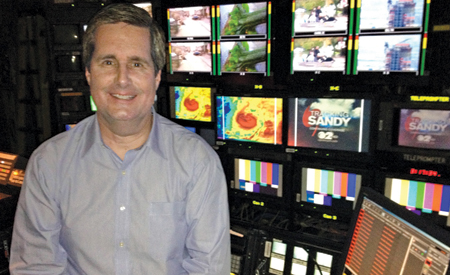
Michael Haynes, WCBS New York
Luck played a role in some of the stations’ jaw-dropping coverage. Haynes just happened to have the only camera team around when the Brooklyn-Battery Tunnel began flooding and used that footage often. One of Zucker’s reporters in Atlantic City encountered some maintenance workers who allowed him to ride out the storm in a high-rise building, where he Skyped vivid images of the boardwalk being splintered. “It was just a fluke that he was where he was and he sent back this amazing footage showing the ripped apart boardwalk,” Zucker says. “It was footage no one else had and our crew worked hard to get it. We used it throughout our coverage.”
Pullekines was fortunate to have what she described as a vantage point that offered one of the best views of the storm at its height. This came from a reporter in Wildwood, N.J., who had been given the keys to a beachfront condo by an evacuating resident. “The reporter had on full rain gear,” says Pullekines, “but after every live shot on the balcony, he had to retreat inside, throw his drenched clothes in the dryer, and then come back out and do it all over again. This determination to rinse, dry and repeat, over and over and over was commendable.”
Roditi remembers a harrowing moment of his coverage involving a reporter who was in the Brighton Beach section of Brooklyn. The floodwaters were ankle deep as he started his news hit. About five minutes into his report, the water was almost at his knees. “That was very surreal,” Roditi says. But being caught up in the moment she went on reporting from the scene and finally wrapped as the anchors in the studio expressed concern for her safety.
“Having worked with certain reporters for a number of years, it was kind of nerve-racking to see them face the dangers of being in the elements,” says Roditi. “It made it more real because it was someone I personally knew out in the storm.”
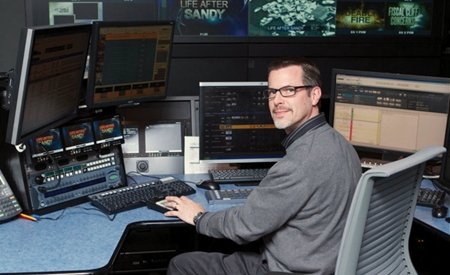
(above) Paul Zucker, WKYW Philadelphia (below) Randy Roditi, WNYW New York
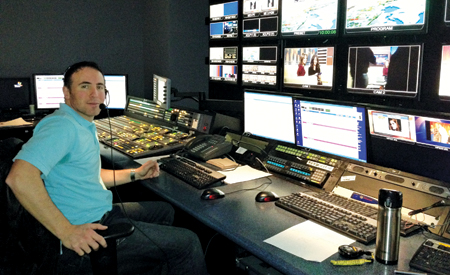
But for the most part, adds Roditi, “I found it easy to detach and compartmentalize the pictures I was seeing from the job I had to do. You’re more concerned with going from point A to point B then stopping to reflect on what you’re putting on the air.”
It wasn’t until the next morning that the extent of the damage became apparent; and far more sobering to those directing the disaster coverage.
“You become so immersed in your job and keeping a good-looking, clean product on the air, you almost become numb to the gravity of the situation. You’re constantly juggling all the technical elements and asking ‘What live shot is available?’” explains Pullekines. “It wasn’t until Tuesday morning that the ‘numbing’ wore off and we saw the first images of the utter devastation that had taken place. It is incredibly difficult to watch the video repeatedly and continue to keep your chin up and focused on the job at hand. There were times that you just wanted to walk out of the building and cry for the many folks that lost everything. You have to remind yourself that you are still on the air trying to provide a service to the community.”
The next day, says McNeeley, “The same reporters were back out at their locations, but the story had changed; the destruction was now evident. We saw houses moved off their foundations, boats on top of cars, the treasures in people’s lives had become the trash that now littered the streets and curbs of their neighborhoods. I almost felt that this was harder to cover than the actual storm.”
Haynes recalls being haunted by footage of Breezy Point, where an entire community was destroyed by fire in the midst of whipping wind and rain. “The images didn’t come in until Tuesday morning. You saw aerial footage that took your breath away,” he says. “It was hard work to maintain your focus. You saw iconic landmark locations that had never looked like that before, and would never again look the way they had.”
On an even more personal note, says McNeeley, “I had enjoyed the rides at Point Pleasant [N.J.] and have many stories from the boardwalk at Seaside Heights. I’ve driven Route 35 countless times but now that road is blocked by homes that were moved off their foundations. People’s lives will be impacted forever by this storm. They may never recover what they lost. Families who can least afford to lose anything, have lost everything.”
For some of the directors, the most memorable visual; and perhaps the one most indicative of Sandy’s fearsome power; was the image of a Seaside Heights, N.J., roller coaster residing uneasily in the Atlantic Ocean. “The closest image I can compare it to would be the Statue of Liberty scene in the original Planet of the Apes,” says Roditi. “The footage of the roller coaster first reached us as still photos. The next day we had the chopper over the harder hit areas, and seeing pictures from the air gave a greater sense of scope and depth to the devastation. The images that the reporters would send back were a small microcosm of devastation. Aerial footage drove the point home in terms of how damaging the storm really was.”
As emotionally and physically wrenching as those few days were, the news directors interviewed here say they were proud to have overseen the coverage through which most people witnessed these historical events.
Haynes realized the scope of what had occurred when he was leaving the newsroom at 6:30 p.m. the night after the storm. “The CBS Evening News was coming on, and all of our footage was leading the national news. When you see and hear something like that, you realize that you’ve been part of a big story, national news, even international news.”